《计算机网络》课程PPT教学课件(自顶向下方法,英文第三版)第二章 Application Layer
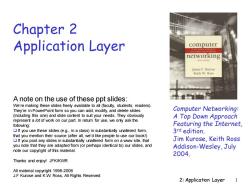
Chapter 2 Application Layer computer networking James F.Kurose Keith W.Ross A note on the use of these ppt slides: We're making these slides freely available to all(faculty,students,readers). They're in PowerPoint form so you can add,modify,and delete slides Computer Networking: (including this one)and slide content to suit your needs.They obviously A Top Down Approach represent a lot of work on our part.In return for use,we only ask the following: Featuring the Internet, f you use these slides(e.g.,in a class)in substantially unaltered form, 3rd edition. that you mention their source(after all,we'd like people to use our book!) f you post any slides in substantially unaltered form on a ww site,that Jim Kurose,Keith Ross you note that they are adapted from(or perhaps identical to)our slides,and Addison-Wesley,July note our copyright of this material. 2004. Thanks and enjoy!JFK/KWR All material copyright 1996-2006 J.F Kurose and K.W.Ross,All Rights Reserved 2:Application Layer 1
2: Application Layer 1 Chapter 2 Application Layer Computer Networking: A Top Down Approach Featuring the Internet, 3rd edition. Jim Kurose, Keith Ross Addison-Wesley, July 2004. A note on the use of these ppt slides: We’re making these slides freely available to all (faculty, students, readers). They’re in PowerPoint form so you can add, modify, and delete slides (including this one) and slide content to suit your needs. They obviously represent a lot of work on our part. In return for use, we only ask the following: ❑ If you use these slides (e.g., in a class) in substantially unaltered form, that you mention their source (after all, we’d like people to use our book!) ❑ If you post any slides in substantially unaltered form on a www site, that you note that they are adapted from (or perhaps identical to) our slides, and note our copyright of this material. Thanks and enjoy! JFK/KWR All material copyright 1996-2006 J.F Kurose and K.W. Ross, All Rights Reserved
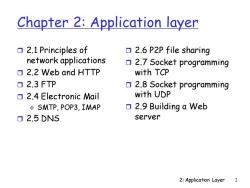
Chapter 2:Application layer ▣2.1 Principles of 2.6 P2P file sharing network applications 2.7 Socket programming 2.2 Web and HTTP with TCP 2.3 FTP 2.8 Socket programming ▣2.4 Electronic Mail with UDP ÷SMTP,POP3,IMAP 2.9 Building a Web ▣2.5DNS server 2:Application Layer 2
2: Application Layer 2 Chapter 2: Application layer 2.1 Principles of network applications 2.2 Web and HTTP 2.3 FTP 2.4 Electronic Mail ❖ SMTP, POP3, IMAP 2.5 DNS 2.6 P2P file sharing 2.7 Socket programming with TCP 2.8 Socket programming with UDP 2.9 Building a Web server

Chapter 2:Application Layer Our goals: learn about protocols ▣conceptual,. by examining popular implementation application-level aspects of network protocols application protocols *HTTP transport-layer FTP service models ÷SMTP/POP3/IMAP *client-server DNS paradigm ▣programming network peer-to-peer applications paradigm socket API 2:Application Layer 3
2: Application Layer 3 Chapter 2: Application Layer Our goals: conceptual, implementation aspects of network application protocols ❖ transport-layer service models ❖ client-server paradigm ❖ peer-to-peer paradigm learn about protocols by examining popular application-level protocols ❖ HTTP ❖ FTP ❖ SMTP / POP3 / IMAP ❖ DNS programming network applications ❖ socket API
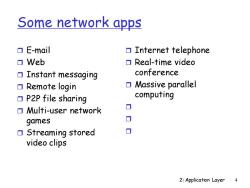
Some network apps OE-mail Internet telephone OWeb Real-time video ▣Instant messaging conference Remote login ▣Massive parallel P2P file sharing computing 口Aulti-user network ▣ games 0 ▣Streaming stored 0 video clips 2:Application Layer 4
2: Application Layer 4 Some network apps E-mail Web Instant messaging Remote login P2P file sharing Multi-user network games Streaming stored video clips Internet telephone Real-time video conference Massive parallel computing

Creating a network app Write programs that application transport run on different end network data link systems and physical communicate over a network. e.g.,Web:Web server software communicates with browser software little software written for devices in network core application application TransporT network core devices do transport network network data link not run user application data link physical physical code application on end systems allows for rapid app development,propagation 2:Application Layer 5
2: Application Layer 5 Creating a network app Write programs that ❖ run on different end systems and ❖ communicate over a network. ❖ e.g., Web: Web server software communicates with browser software little software written for devices in network core ❖ network core devices do not run user application code ❖ application on end systems allows for rapid app development, propagation application transport network data link physical application transport network data link physical application transport network data link physical
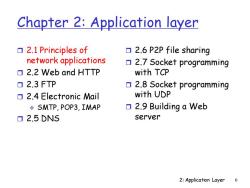
Chapter 2:Application layer ▣2.1 Principles of 2.6 P2P file sharing network applications 2.7 Socket programming 2.2 Web and HTTP with TCP ▣2.3FTP 2.8 Socket programming 口2.4 Electronic Mail with UDP SMTP,POP3,IMAP 2.9 Building a Web ▣2.5DNS server 2:Application Layer 6
2: Application Layer 6 Chapter 2: Application layer 2.1 Principles of network applications 2.2 Web and HTTP 2.3 FTP 2.4 Electronic Mail ❖ SMTP, POP3, IMAP 2.5 DNS 2.6 P2P file sharing 2.7 Socket programming with TCP 2.8 Socket programming with UDP 2.9 Building a Web server
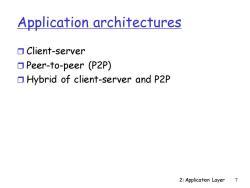
Application architectures ▣Client-server ▣Peer-to-peer(P2P) OHybrid of client-server and P2P 2:Application Layer 7
2: Application Layer 7 Application architectures Client-server Peer-to-peer (P2P) Hybrid of client-server and P2P

Client-server architecture server: always-on host permanent IP address server farms for scaling clients: communicate with server may be intermittently connected may have dynamic IP addresses *do not communicate directly with each other 2:Application Layer 8
2: Application Layer 8 Client-server architecture server: ❖ always-on host ❖ permanent IP address ❖ server farms for scaling clients: ❖ communicate with server ❖ may be intermittently connected ❖ may have dynamic IP addresses ❖ do not communicate directly with each other

Pure P2P architecture no always-on server arbitrary end systems directly communicate peers are intermittently connected and change IP addresses ▣example:Gnutella Highly scalable but difficult to manage 2:Application Layer 9
2: Application Layer 9 Pure P2P architecture no always-on server arbitrary end systems directly communicate peers are intermittently connected and change IP addresses example: Gnutella Highly scalable but difficult to manage

Hybrid of client-server and P2P Skype Internet telephony app Finding address of remote party:centralized server(s) Client-client connection is direct(not through server) Instant messaging Chatting between two users is P2P *Presence detection/location centralized: User registers its IP address with central server when it comes online User contacts central server to find IP addresses of buddies 2:Application Layer 10
2: Application Layer 10 Hybrid of client-server and P2P Skype ❖ Internet telephony app ❖ Finding address of remote party: centralized server(s) ❖ Client-client connection is direct (not through server) Instant messaging ❖ Chatting between two users is P2P ❖ Presence detection/location centralized: • User registers its IP address with central server when it comes online • User contacts central server to find IP addresses of buddies
按次数下载不扣除下载券;
注册用户24小时内重复下载只扣除一次;
顺序:VIP每日次数-->可用次数-->下载券;
- 《计算机网络》课程PPT教学课件(自顶向下方法,英文第三版)第三章 Transport Layer.ppt
- 《计算机网络》课程PPT教学课件(自顶向下方法,英文第三版)第七章 Multimedia Networking.ppt
- 《计算机网络》课程PPT教学课件(自顶向下方法,英文第三版)第一章 Computer Networks and the Internet.ppt
- 《计算机网络》课程教学大纲(供四年制计算机科学与技术本科专业使用).pdf
- 《计算机网络》课程授课教案(双语,计算机科学与技术专业).doc
- 《网页制作》课程教学资源(讲义)第四章.doc
- 《网页制作》课程教学资源(讲义)第十章.doc
- 《网页制作》课程教学资源(讲义)第十一章.doc
- 《网页制作》课程教学资源(讲义)第六章.doc
- 《网页制作》课程教学资源(讲义)第八章.doc
- 《网页制作》课程教学资源(讲义)第五章.doc
- 《网页制作》课程教学资源(讲义)第九章.doc
- 《网页制作》课程教学资源(讲义)第三章.doc
- 《网页制作》课程教学资源(讲义)第七章.doc
- 《网页制作》课程教学资源(讲义)第一章和第二章(石河子大学:李伟).doc
- 西安电子科技大学:《微机原理与系统设计》课程教学课件(讲稿)第4章 汇编语言指令与程序设计 4.6 子程序设计.pdf
- 西安电子科技大学:《微机原理与系统设计》课程教学课件(讲稿)第2章 8086CPU的结构与功能.pdf
- 西安电子科技大学:《微机原理与系统设计》课程教学课件(讲稿)第4章 汇编语言指令与程序设计 4.2 数据运算指令与程序设计.pdf
- 西安电子科技大学:《微机原理与系统设计》课程教学课件(讲稿)第4章 汇编语言指令与程序设计 4.5 循环程序设计.pdf
- 西安电子科技大学:《微机原理与系统设计》课程教学课件(讲稿)第6章 存储器设计.pdf
- 《计算机网络》课程PPT教学课件(自顶向下方法,英文第三版)第五章 Link Layer and LANs.ppt
- 《计算机网络》课程PPT教学课件(自顶向下方法,英文第三版)第六章 Wireless and Mobile Networks.ppt
- 《计算机网络》课程PPT教学课件(自顶向下方法,英文第三版)第四章 Network Layer.ppt
- 《计算机网络》课程PPT教学课件(自顶向下方法,英文第三版)第九章 Network Management.ppt
- 《计算机网络》课程PPT教学课件(自顶向下方法,英文第三版)第八章 Network Security.ppt
- 《计算机网络》课程PPT教学课件(自顶向下方法,中文第三版)第一章 计算机网络和因特网概述.ppt
- 《计算机网络》课程PPT教学课件(自顶向下方法,中文第三版)第三章 运输层.ppt
- 《计算机网络》课程PPT教学课件(自顶向下方法,中文第三版)第二章 应用层.ppt
- 《计算机网络》课程PPT教学课件(自顶向下方法,中文第三版)第五章 链路层与局域网.ppt
- 《计算机网络》课程PPT教学课件(自顶向下方法,中文第三版)第六章 无线网和移动网.ppt
- 《计算机网络》课程PPT教学课件(自顶向下方法,中文第三版)第四章 网络层.ppt
- 《计算机网络》课程PPT教学课件(自顶向下方法,中文第三版)第七章 多媒体联网.ppt
- 《计算机网络》课程PPT教学课件(自顶向下方法,中文第三版)第九章 网络管理.ppt
- 《计算机网络》课程PPT教学课件(自顶向下方法,中文第三版)第八章 网络安全.ppt
- 《The Basics of Information Security》参考书籍PDF电子版(Understanding the Fundamentals of InfoSec in Theory and Practice,作者:Jason Andress).pdf
- 华南农业大学:《高级语言程序设计》课程授课教案(负责人:刘财兴).pdf
- 华南农业大学:《高级语言程序设计》课程教学大纲 Programming.pdf
- 华南农业大学:《高级语言程序设计》课程教学资源(PPT课件)chap01_概论.ppt
- 华南农业大学:《高级语言程序设计》课程教学资源(PPT课件)chap02_用C语言编写程序.ppt
- 华南农业大学:《高级语言程序设计》课程教学资源(PPT课件)chap03_分支结构.ppt
